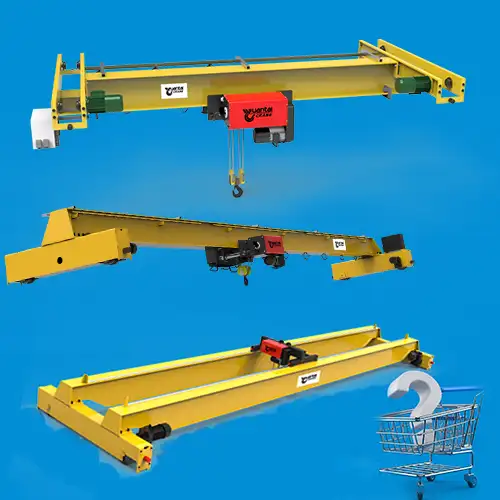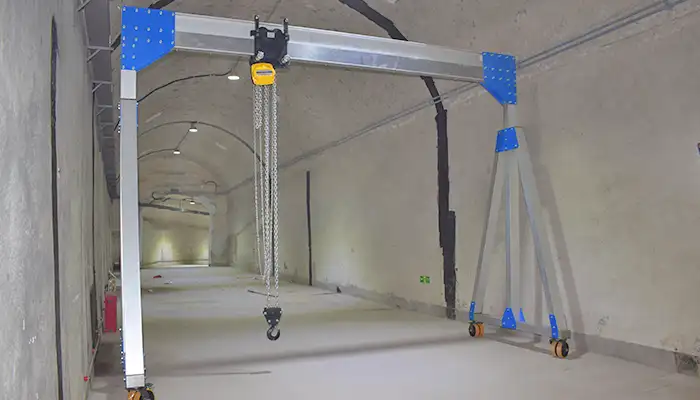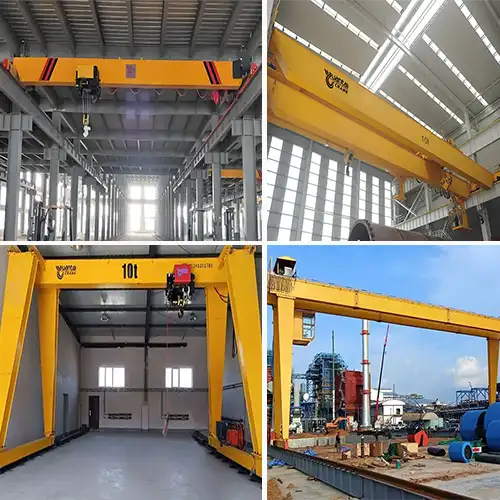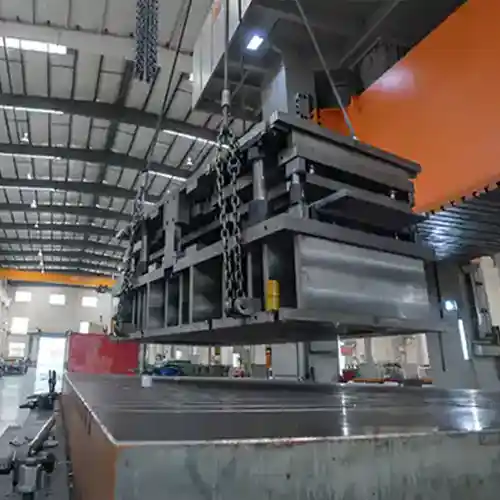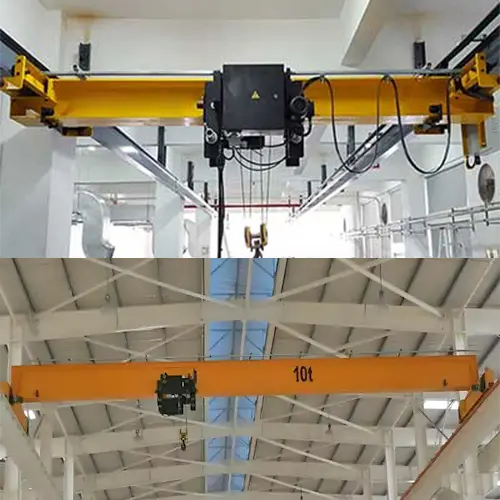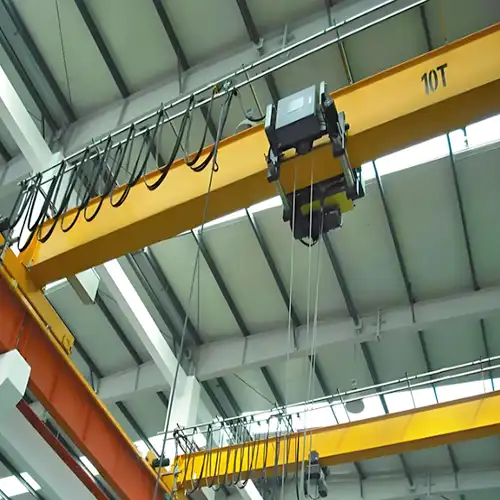10 Vital Questions to Ask When Buying a 10 Ton Overhead Crane
Buy 10 ton overheadc crane for your particular needs at cost-effective price. 10 questions you need to kown to buy overhead bridge crane effectively. Click!
Category: 10 Ton Overhead Crane
Your Trusted 10 Ton Overhead Crane Manufacturer & Supplier
10 Vital Questions to Ask When Buying a 10 Ton Overhead Crane
Investing in a 10 ton overhead crane is a significant decision for any business. Whether it's for lifting heavy machinery in a manufacturing facility or streamlining warehouse operations, choosing the right crane requires careful consideration. At the heart of this decision-making process lies the importance of thorough preparation. Before diving headfirst into purchasing a crane, it's crucial to ask the right questions to ensure that your investment aligns with your needs and objectives.
In this guide, we'll put more details into the ten vital questions you should ask when buying a 10 ton overhead crane. By asking these questions upfront, you'll be better equipped to make an informed decision that maximizes efficiency, safety, and long-term value for your business. Let's explore each of these questions in detail to understand their significance in the purchasing process. Buy 10 ton overheadc crane for your particular needs at cost-effective price. 10 questions you need to kown to buy overhead bridge crane effectively. Click!
Purpose and Usage
What are the primary purposes for which you intend to use the 10 ton overhead crane?
Choosing the right 10 ton overhead crane starts with understanding its intended purpose and usage within your operation. Here's why this question is crucial:
- Efficiency Optimization: Identifying the primary purposes for which you intend to use the crane allows you to select a model that is specifically designed to meet those needs. Whether it's lifting heavy machinery, loading and unloading materials, or facilitating assembly processes, a crane tailored to your specific tasks can significantly enhance operational efficiency.
- Safety Considerations: Different applications may require different safety features or load capacities. By clarifying the intended usage upfront, you can ensure that the crane you choose is equipped with the necessary safety mechanisms to protect both your workers and your assets.
- Space and Layout Requirements: The intended purpose of the crane will also impact factors such as its size, reach, and mobility. Understanding how you plan to use the crane within your facility allows you to assess space constraints and layout considerations, ensuring that the chosen crane fits seamlessly into your workflow.
- Long-Term Planning: By defining the primary purposes for the crane, you can also anticipate future needs and potential growth within your operation. This proactive approach enables you to invest in a crane that not only meets your current requirements but also offers scalability and flexibility for future expansion.
In summary, clarifying the primary purposes for which you intend to use the 10 ton overhead crane is essential for selecting the right model that maximizes efficiency, safety, and adaptability within your operation. This upfront consideration lays the foundation for a successful crane investment that delivers long-term value for your business.
Environment and Safety
Will the crane be used indoors or outdoors?
What safety certifications does the crane meet?
Ensuring the safety and suitability of the environment where the 10 ton overhead crane will operate is paramount. Here's why understanding the environment and safety considerations is crucial:
- Indoor vs. Outdoor Usage: Determining whether the crane will be used indoors or outdoors is essential for selecting the appropriate crane design and materials. Indoor cranes may have different structural requirements compared to outdoor cranes to withstand environmental elements such as moisture, temperature fluctuations, and corrosion. Understanding the operating environment allows you to choose a crane that is durable and performs optimally in its intended setting.
- Safety Certifications: Safety is non-negotiable when it comes to overhead crane operations. Inquiring about the safety certifications that the crane meets ensures compliance with industry standards and regulatory requirements. Certifications such as CE (Conformité Européenne) and ANSI (American National Standards Institute) indicate that the crane has undergone rigorous testing and meets stringent safety standards. Choosing a crane with the appropriate safety certifications provides peace of mind and minimizes the risk of accidents or injuries in the workplace.
- Worker Protection: The safety of your workers is paramount. By selecting a crane with the right safety features and certifications, you can create a secure working environment and minimize the risk of workplace accidents. Features such as overload protection systems, emergency stop buttons, and safety alarms enhance worker protection and contribute to a safer work environment.
- Legal Compliance: Operating a crane that meets safety standards and certifications is not only essential for worker safety but also for legal compliance. Failure to comply with safety regulations can result in costly fines, legal liabilities, and reputational damage to your business. By ensuring that the crane meets all necessary safety certifications, you can mitigate legal risks and demonstrate your commitment to workplace safety.
In conclusion, understanding the operating environment and ensuring compliance with safety certifications are crucial steps in the purchasing process of a 10 ton overhead crane. By addressing these considerations upfront, you can select a crane that is not only well-suited to its operating environment but also prioritizes the safety of your workers and complies with regulatory requirements.
Technical Specifications
What are the dimensions and space requirements?
What are the power supply requirements?
Understanding the technical specifications of a 10 ton overhead crane is crucial for ensuring it meets your operational needs effectively. Here's why paying attention to dimensions, space requirements, and power supply is essential:
- Dimensions and Space Requirements: The dimensions of the crane and its space requirements directly impact its installation and operation within your facility. Knowing the crane's dimensions allows you to assess whether it can maneuver through aisles, clear obstacles, and fit within existing structures. Additionally, understanding the space requirements ensures there's sufficient clearance for safe operation and maintenance. By considering these factors, you can avoid potential spatial constraints that may hinder crane performance or pose safety risks.
- Power Supply Requirements: Overhead cranes rely on electrical power to operate efficiently. Understanding the crane's power supply requirements, including voltage, phase, and frequency, is essential for ensuring compatibility with your facility's electrical infrastructure. Additionally, assessing power requirements helps prevent overloading circuits and electrical systems, which can lead to downtime and potential safety hazards. By aligning the crane's power needs with your facility's electrical capabilities, you can ensure seamless integration and reliable operation.
By paying attention to the technical specifications related to dimensions, space requirements, and power supply, businesses can select a 10 ton overhead crane that fits seamlessly into their operations while ensuring safety, efficiency, and compatibility with existing infrastructure.
Cost and Budget
Can you provide a detailed cost breakdown?
Considering the cost and budget is a crucial aspect of purchasing a 10 ton overhead crane. Here's why asking for a detailed cost breakdown is essential:
- Transparency and Clarity: Requesting a detailed cost breakdown allows you to understand exactly what you're paying for. It provides transparency into the pricing structure, including the cost of the crane itself, any additional features or customization, as well as taxes, fees, and other charges. With a clear breakdown, you can identify any potential hidden costs and ensure that the quoted price aligns with your budgetary constraints.
- Comparative Analysis: A detailed cost breakdown enables you to compare quotes from different suppliers more effectively. By examining the breakdowns side by side, you can assess the value proposition offered by each supplier and identify any disparities in pricing or included features. This comparative analysis empowers you to make an informed decision based on both cost and value, ensuring that you get the best possible deal for your investment.
- Budget Planning: Understanding the cost breakdown helps you plan and allocate your budget more effectively. By knowing the individual costs associated with the crane purchase, you can allocate funds accordingly and avoid unexpected financial burdens. Whether it's setting aside funds for upfront payment or budgeting for ongoing maintenance and operational costs, having a clear understanding of the expenses involved allows for better financial planning and management.
- Negotiation Leverage: A detailed cost breakdown provides valuable leverage during price negotiations with suppliers. Armed with a clear understanding of the costs involved, you can negotiate more effectively, seeking adjustments or discounts where appropriate. Whether it's negotiating lower prices for certain features or services or requesting additional value-added benefits, having a comprehensive cost breakdown strengthens your position at the negotiating table.
In summary, requesting a detailed cost breakdown is essential for transparency, comparative analysis, budget planning, and negotiation leverage when purchasing a 10 ton overhead crane. By understanding the costs involved upfront, businesses can make informed decisions that align with their budgetary constraints and maximize the value of their investment.
Supplier Evaluation
What is the supplier's reputation in the industry?
Assessing the reputation of the supplier is a critical step when purchasing a 10 ton overhead crane. Here's why evaluating the supplier's reputation in the industry is essential:
- Reliability and Trustworthiness: The reputation of the supplier reflects its reliability and trustworthiness as a business partner. A supplier with a positive reputation is more likely to deliver high-quality products, provide excellent customer service, and honor commitments. By choosing a reputable supplier, you can mitigate the risk of delays, defects, or other issues that may arise during the procurement process.
- Quality Assurance: Suppliers with a strong reputation in the industry are often known for their commitment to quality. They may have robust quality assurance processes in place to ensure that their products meet or exceed industry standards. By selecting a reputable supplier, you can have confidence in the quality and reliability of the overhead crane, reducing the likelihood of premature failures or malfunctions.
- Customer Satisfaction: A supplier's reputation is closely tied to the satisfaction of its customers. Positive reviews, testimonials, and references from past clients can provide valuable insights into the supplier's track record of delivering satisfactory outcomes. By researching customer feedback and experiences, you can gauge the supplier's performance, responsiveness, and ability to meet customer expectations.
- Long-Term Relationship: Choosing a reputable supplier fosters the potential for a long-term relationship built on trust and mutual respect. A supplier who values its reputation is more likely to prioritize customer satisfaction, ongoing support, and collaboration. By establishing a positive working relationship with a reputable supplier, you can benefit from consistent product quality, reliable service, and potential cost savings over time.
In summary, evaluating the supplier's reputation in the industry is essential for ensuring reliability, quality assurance, customer satisfaction, and long-term relationship building when purchasing a 10 ton overhead crane. By selecting a reputable supplier with a positive track record, businesses can minimize risks and maximize the likelihood of a successful procurement experience.
Customization Options
What customization options are available?
Exploring the customization options available for a 10 ton overhead crane is crucial for tailoring the crane to your specific operational needs. Here's why understanding customization options is essential:
- Tailored Solutions: Every business has unique requirements when it comes to overhead crane operations. Customization options allow you to tailor the crane to your specific needs, ensuring that it aligns perfectly with your workflow, facility layout, and lifting requirements. Whether you need to adjust the crane's lifting capacity, span, or operational controls, customization options provide flexibility to create a solution that meets your exact specifications.
- Enhanced Efficiency: Customizing the crane to your specific requirements can significantly enhance operational efficiency. By incorporating features such as specialized lifting attachments, variable speed controls, or advanced safety systems, you can streamline workflows, improve productivity, and optimize resource utilization. Customization options allow you to design a crane that maximizes efficiency and performance in your unique operational environment.
- Adaptability to Changing Needs: Investing in a crane with customization options ensures adaptability to changing business needs and evolving industry trends. As your operation grows or requirements change over time, you can easily modify the crane to accommodate new challenges or opportunities. Whether it's expanding the crane's capabilities, integrating new technology, or adjusting its configuration, customization options provide the flexibility to future-proof your investment and maintain competitiveness in the market.
- Safety and Compliance: Customization options also play a crucial role in enhancing safety and ensuring regulatory compliance. By incorporating specialized safety features or compliance upgrades tailored to your industry or application, you can mitigate risks, prevent accidents, and maintain compliance with industry standards and regulations. Customization options allow you to prioritize safety and ensure that the crane meets all necessary requirements for safe and reliable operation.
In summary, exploring customization options for a 10 ton overhead crane is essential for tailoring the crane to your specific operational needs, enhancing efficiency, adaptability, safety, and compliance. By understanding the customization options available, businesses can design a crane that maximizes productivity, minimizes risks, and delivers long-term value for their operation.
Future Growth and Scalability
How does the crane accommodate future growth?
Considering how a 10 ton overhead crane accommodates future growth is crucial for long-term planning and investment. Here's why evaluating its scalability is essential:
- Anticipating Business Expansion: As businesses evolve and grow, their material handling needs may change. An overhead crane that accommodates future growth enables businesses to scale their operations without requiring significant investments in new equipment. By assessing how the crane can adapt to increasing production volumes, expanding product lines, or changes in workflow processes, businesses can ensure that their material handling infrastructure remains capable of supporting their growth trajectory.
- Flexible Configuration Options: A scalable overhead crane offers flexible configuration options that allow for easy adjustments to meet evolving needs. Whether it's increasing the crane's lifting capacity, extending its span, or adding new features and accessories, having the flexibility to modify the crane ensures adaptability to changing requirements. By choosing a crane with scalable configuration options, businesses can future-proof their investment and minimize the need for costly replacements or upgrades as their operations expand.
- Modular Design and Upgradeability: Modular design and upgradeability are key characteristics of a scalable overhead crane. A crane with modular components and upgradeable features enables businesses to incrementally expand its capabilities over time. Whether it's adding new hoists, upgrading controls, or integrating advanced technology, businesses can enhance the crane's performance and functionality without replacing the entire system. This modular approach to expansion allows for cost-effective upgrades that align with the pace of business growth.
- Integration with Advanced Technology: Scalable overhead cranes often leverage advanced technology to enhance their scalability and adaptability. Features such as predictive maintenance, remote monitoring, and automation capabilities enable businesses to optimize crane performance, minimize downtime, and improve efficiency as they grow. By investing in a crane that integrates with advanced technology solutions, businesses can future-proof their material handling operations and stay competitive in a rapidly evolving market.
In summary, evaluating how a 10 ton overhead crane accommodates future growth is essential for long-term planning and investment. By assessing its scalability, flexibility, modular design, and integration with advanced technology, businesses can ensure that their material handling infrastructure remains capable of supporting their growth trajectory and evolving operational needs.
Long-term Value
What is the long-term value and return on investment?
To know the long-term value and return on investment (ROI) of a 10 ton overhead crane is crucial for making informed purchasing decisions. Here's why assessing long-term value and ROI is essential:
- Total Cost of Ownership: Evaluating the long-term value of the crane involves considering its total cost of ownership over its expected lifespan. This includes not only the initial purchase price but also ongoing operational costs such as maintenance, repairs, energy consumption, and downtime. By calculating the total cost of ownership, businesses can assess the true financial impact of the crane investment and determine its overall value proposition.
- ROI Analysis: Conducting a thorough ROI analysis helps quantify the financial benefits derived from the crane investment over time. This involves comparing the upfront costs of purchasing and installing the crane against the expected benefits, such as increased productivity, efficiency gains, labor savings, and revenue generation. By estimating the payback period and net present value of the investment, businesses can determine whether the crane will deliver a positive return on investment and contribute to their bottom line over the long term.
- Quality and Durability: Assessing the long-term value of the crane also involves evaluating its quality, durability, and reliability. A crane constructed from high-quality materials, with robust engineering and craftsmanship, is likely to have a longer lifespan and require fewer repairs and replacements over time. By investing in a durable and reliable crane, businesses can minimize lifecycle costs, reduce the risk of unexpected failures, and maximize the overall value of their investment.
- Adaptability and Future-Proofing: Considering the crane's adaptability and future-proofing capabilities is essential for long-term value. A crane that can accommodate future growth, technological advancements, and changes in operational requirements offers greater longevity and versatility. By selecting a crane with scalability options, modular design, and compatibility with advanced technology, businesses can ensure that their investment remains relevant and effective in the face of evolving industry trends and market dynamics.
In summary, assessing the long-term value and return on investment of a 10 ton overhead crane involves considering its total cost of ownership, conducting an ROI analysis, evaluating quality and durability, and assessing adaptability and future-proofing capabilities. By understanding the financial implications and benefits of the crane investment over time, businesses can make informed decisions that maximize value and contribute to long-term success.
Conclusion
In conclusion, the process of purchasing a 10 ton overhead crane involves careful consideration of various factors to ensure that the investment meets your operational needs, budgetary constraints, and long-term objectives. Asking the 10 key questions outlined in this article is essential for making an informed decision and maximizing the value of your crane investment.
By thoroughly assessing the purpose and usage of the crane, understanding its environmental and safety requirements, evaluating its technical specifications, considering cost and budget constraints, and scrutinizing supplier reputation and customization options, businesses can make informed decisions that align with their specific requirements and objectives.
Furthermore, considering how the crane accommodates future growth, understanding its long-term value and return on investment, and evaluating its scalability and adaptability are crucial for ensuring that the investment remains relevant and effective over time.
In summary, asking these 10 key questions provides businesses with the insights they need to navigate the complex process of purchasing a 10 ton overhead crane successfully. By taking a proactive and thorough approach to procurement, businesses can minimize risks, optimize performance, and ultimately achieve their material handling goals with confidence and clarity.
Main Projects
Related Products
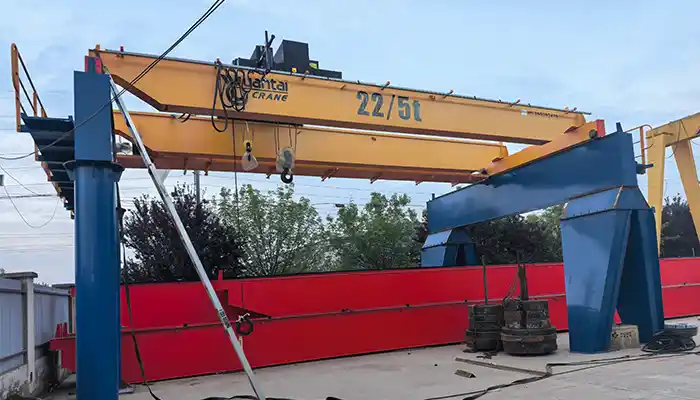
22/5 Ton Overhead Crane Double Hook System: Robust double girder crane with 22-ton main and 5-ton auxiliary hooks for heavy lifting. Get double hook crane!
Free consultation to Confirm Parameters & Specifications and Get
Latest Crane Price & Crane Rate.
- Types of overhead cranes : _______?
- Optional: Overhead travelling crane, goliath gantry crane,Slewing jib crane, Single girder or double girder crane,small portable crane or kbk crane, etc.
- Capacity of overhead crane: _______?
- Optional: 0.25ton, 0.5 ton, 1 ton, 2 ton, 3ton, 5 ton, 10 ton,15ton, 20ton, 25 ton, 30ton,35ton, up to 550ton, etc.
- Crane span & lifting height : _______?
- Crane travelling length : _____?
- Control of overhead crane:_______?
- Optional: pendant/ remote/cabin control
- Voltage supply of overhead crane:_____?
- Eg,: 380V50/60HZ,3Phase or others,etc.
- Application/usage of crane:_______?
- Eg,: Steel mill, ,injection mold, cement,stone, concrete,granite, general manufacturing, etc.
Just leave a message via the contact form and our hoist and crane engineer will contact you with in 24working hours.
Get In Touch
